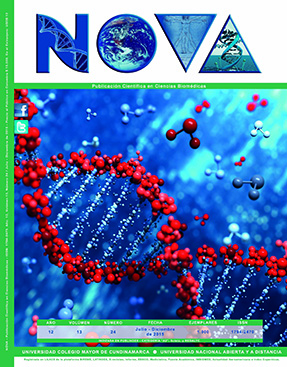Regulación de la familia de proteínas BCL-2 en células infectadas con Chlamydia trachomatis
Regulation of the Bcl-2 protein family in cells infected with Chlamydia trachomatis

NOVA por http://www.unicolmayor.edu.co/publicaciones/index.php/nova se distribuye bajo una Licencia Creative Commons Atribución-NoComercial-SinDerivar 4.0 Internacional.
Así mismo, los autores mantienen sus derechos de propiedad intelectual sobre los artículos.
Mostrar biografía de los autores
El presente artículo revisa los mecanismos inhibitorios de la apoptosis usados por Chlamydia trachomatis (Ct) frente a la familia de proteínas Bcl-2, para lograr su supervivencia intracelular. Chlamydia trachomatis es una bacteria intracelular obligada Gram negativa responsable de la infección de transmisión sexual más común en el mundo; este microorganismo es capaz de inhibir la apoptosis de la célula huésped durante su ciclo de desarrollo, obteniendo un refugio seguro para su supervivencia.
Frente a estímulos como la infección de la célula por un patógeno, la familia de proteínas Bcl-2 regula la apoptosis por medio de la liberación del citocromo c de la mitocondria para desencadenar la muerte celular programada (MCP). Ct usa diversos mecanismos de regulación antiapoptótica para sobrevivir dentro de la célula huésped; dentro de ellos se observa la secreción de proteínas tales como CPAF y CADD, la escisión de la proteína Bid, el secuestro de Bad y en general el bloqueo de proteínas pertenecientes a la familia Bcl-2 con dominio BH3, que afectan directamente la vía mitocondrial ocasionando la persistencia, desarrollo y replicación de Ct en la célula huésped.
Visitas del artículo 188 | Visitas PDF 99
Descargas
- Ying S, Pettengill M, Ojcius DM, Hacker G. Host-Cell Survival and Death During Chlamydia Infection. Curr Immunol Rev 2007;3(1):31-40.
- Cocchiaro JL, Valdivia RH. New insights into Chlamydia intracellular survival mechanisms. Cell Microbiol 2009 Nov;11(11):1571-8.
- Huang Z, Feng Y, Chen D, Wu X, Huang S, Wang X, et al. Structural basis for activation and inhibition of the secreted chlamydia protease CPAF. Cell Host Microbe 2008 Dec 11;4(6):529-42.
- Abdelrahman YM. The chlamydial developmental cycle. 2005 Nov.
- Verbeke P, Welter-Stahl L, Ying S, Hansen J, Hacker G, Darville T, et al. Recruitment of BAD by the Chlamydia trachomatis vacuole correlates with host-cell survival. PLoS Pathog 2006 May; 2(5):e45.
- Ambrosini G, Adida C, Altieri DC. A novel anti-apoptosis gene, survivin, expressed in cancer and lymphoma. Nat Med 1997 Aug; 3(8):917-21.
- Sharma J, Dong F, Pirbhai M, Zhong G. Inhibition of proteolytic activity of a chlamydial proteasome/protease-like activity factor by antibodies from humans infected with Chlamydia trachomatis. Infect Immun 2005 Jul;73(7):4414-9.
- Espinoza M. Apoptosis, muerte celular fisiológica, reseña histórica y actualidad. Revista de Educación en biología 16[2], 153-160. 2014. Ref Type: Journal (Full)
- Stenner-Liewen F, Liewen H, Zapata JM, Pawlowski K, Godzik A, Reed JC. CADD, a Chlamydia protein that interacts with death receptors. J Biol Chem 2002 Mar 22;277(12):9633-6.
- Barnes RC. Laboratory diagnosis of human chlamydial infections. Clin Microbiol Rev 1989 Apr;2(2):119-36.
- Black CM. Current methods of laboratory diagnosis of Chlamydia trachomatis infections. Clin Microbiol Rev 1997 Jan;10(1):160-84.
- Chen AL, Johnson KA, Lee JK, Sutterlin C, Tan M. CPAF: a Chlamydial protease in search of an authentic substrate. PLoS Pathog 2012;8(8):e1002842.
- Broadbent A, Horner P, Wills G, Ling A, Carzaniga R, McClure M. HIV-1 does not significantly influence Chlamydia trachomatis serovar L2 replication in vitro. Microbes Infect 2011 Jun;13(6):575-84.
- Gallegos G, Ramos B, Santiso R, Goyanes V, Gosalvez J, Fernandez JL. Sperm DNA fragmentation in infertile men with genitourinary infection by Chlamydia trachomatis and Mycoplasma. Fertil Steril 2008 Aug;90(2):328-34.
- Pérez JA, Storz J. Género Chlamydia: biología básica, propiedades antigénicas y potencial patogénico. Ciencia vetrinaria 4, 37-60. 1987. Ref Type: Journal (Full)
- Kubo T, Ishida K, Matsuo J, Nakamura S, Hayashi Y, Sakai H, et al. Chlamydia trachomatis serovar L2 infection model using human lymphoid Jurkat cells. Microb Pathog 2012 Jul;53(1):1-11.
- Su H, Raymond L, Rockey DD, Fischer E, Hackstadt T, Caldwell HD. A recombinant Chlamydia trachomatis major outer membrane protein binds to heparan sulfate receptors on epithelial cells. Proc Natl Acad Sci U S A 1996 Oct 1;93(20):11143-8.
- Kerr JF, Wyllie AH, Currie AR. Apoptosis: a basic biological phenomenon with wide-ranging implications in tissue kinetics. Br J Cancer 1972 Aug;26(4):239-57.
- Miyairi I, Byrne GI. Chlamydia and programmed cell death. Curr Opin Microbiol 2006 Feb;9(1):102-8.
- Cervantes E. Infecciones causadas por Chlamydia trachomatis. Rev Fac Med UNAM 52[1], 18-22. 2009. Ref Type: Journal (Full)
- Harvey R, Champe P, Fisher B. Microbiología. 2 ed. España: wolters klumer lippincot; 2008.
- Arráiz N, Marcucci R, Urdaneta B, Colina S, Romero Z. Diagnóstico moelcular en la evaluación de infecciones urogenitales por Chlamydia trachomatis. Revista de Obstetricia y Ginecología de Venezuela 2008;68(0048-7732):195-201.
- Jeong SY, Seol DW. The role of mitochondria in apoptosis. BMB Rep 2008 Jan 31;41(1):11-22.
- Lawen A. Apoptosis-an introduction. Bioessays 2003 Sep;25(9):888-96.
- Sharma M, Rudel T. Apoptosis resistance in Chlamydia-infected cells: a fate worse than death? FEMS Immunol Med Microbiol 2009 Mar;55(2):154-61.
- Cooper G, Hausman R. La célula. 5 ed. 2007.
- Labi V, Grespi F, Baumgartner F, Villunger A. Targeting the Bcl-2-regulated apoptosis pathway by BH3 mimetics: a breakthrough in anticancer therapy? Cell Death Differ 2008 Jun;15(6):977-87.
- Sousa R, Puy D. Histomorfometría, la apoptosis (Bcl-2 y Bax) y el marcador marcador de proliferación celular Ki-67 en neoplasias Intraepitelial cervical Universidad Federal de Minas Gerais; 2011.
- Jeffers JR, Parganas E, Lee Y, Yang C, Wang J, Brennan J, et al. Puma is an essential mediator of p53-dependent and -independent apoptotic pathways. Cancer Cell 2003 Oct;4(4):321-8.
- Fischer SF, Vier J, Kirschnek S, Klos A, Hess S, Ying S, et al. Chlamydia inhibit host cell apoptosis by degradation of proapoptotic BH3-only proteins. J Exp Med 2004 Oct 4;200(7):905-16.
- Byrne GI, Ojcius DM. Chlamydia and apoptosis: life and death decisions of an intracellular pathogen. Nat Rev Microbiol 2004 Oct;2(10):802-8.
- Fletcher JI, Huang DC. BH3-only proteins: orchestrating cell death. Cell Death Differ 2006 Aug;13(8):1268-71.
- Puthalakath H, O'Reilly LA, Gunn P, Lee L, Kelly PN, Huntington ND, et al. ER stress triggers apoptosis by activating BH3-only protein Bim. Cell 2007 Jun 29;129(7):1337-49.
- Ying S, Seiffert BM, Hacker G, Fischer SF. Broad degradation of proapoptotic proteins with the conserved Bcl-2 homology domain 3 during infection with Chlamydia trachomatis. Infect Immun 2005 Mar;73(3):1399-403.
- Labi V, Erlacher M, Kiessling S, Villunger A. BH3-only proteins in cell death initiation, malignant disease and anticancer therapy. Cell Death Differ 2006 Aug;13(8):1325-38.
- Gallenne T, Gautier F, Oliver L, Hervouet E, Noel B, Hickman JA, et al. Bax activation by the BH3-only protein Puma promotes cell dependence on antiapoptotic Bcl-2 family members. J Cell Biol 2009 Apr 20;185(2):279-90.
- Ortiz G. Mecanismos moleculares que regulan la sensibilidad de células tumorales de mama a la apoptosis por TRAIL Instituto de parasitología y biomedicina de granada; 2005.
- Starr TK, Jameson SC, Hogquist KA. Positive and negative selection of T cells. Annu Rev Immunol 2003;21:139-76.
- Fan T, Lu H, Hu H, Shi L, McClarty GA, Nance DM, et al. Inhibition of apoptosis in chlamydia-infected cells: blockade of mitochondrial cytochrome c release and caspase activation. J Exp Med 1998 Feb 16;187(4):487-96.
- Greene W, Xiao Y, Huang Y, McClarty G, Zhong G. Chlamydia-infected cells continue to undergo mitosis and resist induction of apoptosis. Infect Immun 2004 Jan;72(1):451-60.
- Dean D, Powers VC. Persistent Chlamydia trachomatis infections resist apoptotic stimuli. Infect Immun 2001 Apr;69(4):2442-7.
- Jorgensen I, Bednar MM, Amin V, Davis BK, Ting JP, McCafferty DG, et al. The Chlamydia protease CPAF regulates host and bacterial proteins to maintain pathogen vacuole integrity and promote virulence. Cell Host Microbe 2011 Jul 21;10(1):21-32.
- Pirbhai M, Dong F, Zhong Y, Pan KZ, Zhong G. The secreted protease factor CPAF is responsible for degrading pro-apoptotic BH3-only proteins in Chlamydia trachomatis-infected cells. J Biol Chem 2006 Oct 20;281(42):31495-501.
- Ying S, Fischer SF, Pettengill M, Conte D, Paschen SA, Ojcius DM, et al. Characterization of host cell death induced by Chlamydia trachomatis. Infect Immun 2006 Nov;74(11):6057-66.
- Dong F, Pirbhai M, Xiao Y, Zhong Y, Wu Y, Zhong G. Degradation of the proapoptotic proteins Bik, Puma, and Bim with Bcl-2 domain 3 homology in Chlamydia trachomatis-infected cells. Infect Immun 2005 Mar;73(3):1861-4.
- Perfettini JL, Reed JC, Israel N, Martinou JC, Dautry-Varsat A, Ojcius DM. Role of Bcl-2 family members in caspase-independent apoptosis during Chlamydia infection. Infect Immun 2002 Jan;70(1):55-61.
- Fischer SF, Schwarz C, Vier J, Hacker G. Characterization of antiapoptotic activities of Chlamydia pneumoniae in human cells. Infect Immun 2001 Nov;69(11):7121-9.
- ==========================================
- DOI: http://dx.doi.org/10.22490/24629448.1718





